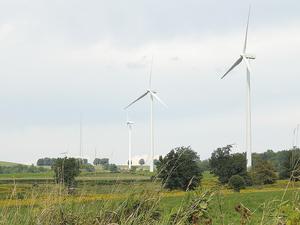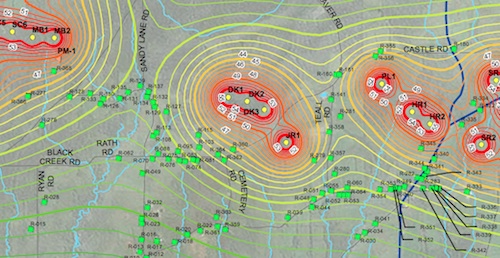NY windfarm latest to trigger noise issues – it’s easy to see why
Human impacts, News, Wind turbines Add commentsA sprawling wind farm in northern New York state is the latest new installation to trigger push-back from neighbors complaining about excessive noise. The Hardscrabble Wind Project is centered in Fairfield, just north of I-90 between Syracuse and Albany; its three-dozen turbines stretch across parts of three towns, covering an area of roughly ten miles by three miles.

A recent local press report summarizes the current situation: several nearby residents have complained of noise issues, leading the developer, Iberdrola, and the town of Fairfield to commission noise studies to determine what sound levels were occurring. The Iberdrola study found that sound was generally in line with the predictions made during project planning, falling below the regulatory limit of 50dB, though in high winds some recordings came in above that with combined turbine and ambient wind noise. The town study will take place this winter, when the leaves are off the trees.
UPDATE, 10/4/11: Good local article on the preparations for the new noise study, with a classic example of neighbors reacting differently to the sound, one saying the noise “is really bad, very hard to live with,” and another saying “to be honest with you, I don’t even notice them.”
A look at the sound assessment documents compiled as the project was being approved offers some hints as to why this project might trigger noise complaints; several factors compound the likelihood of issues here. First is the town’s noise limit of 50dB for non-participating neighbors, which is on the very high end of regulatory limits for wind farms. The sound assessment went through several versions as the project was revised and refined; a noise analysis from March 2009 lists 25 homes where the modeled noise levels were predicted to be between 45 and 50dB; 11 were hosting turbines and 14 were not. An apparently final revised noise analysis dated December 2009 (after some site adjustments to some turbines) does not list the affected homes, but includes very detailed sound contour maps, which show well over a hundred homes sitting in the 40-50dB zone, where it can be expected that a significant minority of residents will find the noise intrusive (based on experience at other wind farms in similar communities, and on the limited research data we have available; for more on this, see AEI’s 2010 NEWEEP presentation on community responses). It all adds up to the classic conditions that have often led to problems in rural towns that are home to many residents who are not actively farming and ranching: too many homes receiving noise levels close to (relatively high) regulatory limits.
The final hint that there might be problems lies in the March noise assessments definition of existing ambient noise. This is often the key factor that is given too little attention in wind farm siting,
because of the correlation between new noise sources being louder than ambient and increasing community noise complaints; 5dB is the threshold for audibility and some complaints, with 10dB considered likely to trigger widespread complaints. The report defines existing ambient as 35dB, which is higher than some other rural New York locations that have been carefully monitored for night time ambient conditions (25dB is not uncommon, with occasional readings down to 20dB). The southern end of the project is within a couple miles of I-90, where it’s quite likely the highway increases the ambient, making the estimate more likely to be valid there; however, in the central and northern reaches of the project, the 35dB assumption may raise some eyebrows. Assuming 35dB as the existing ambient, the models predicted no residents would hear turbine sound of 6dB over that during low wind conditions, though many would hear turbines at 35-40dB (which would be problematic if existing ambient was 25-20dB, as, for example, the state of Oregon assumes in its noise regulations). In addition to these questions about low-power operation, during “full-power” operations, with an assumed ambient level of 41dB, the March noise assessment actually did predict that 9 non-participating neighbors would experience turbine noise of more than 6dB over ambient, a threshold that New York noise regulations aim to avoid. (Nine more were predicted to experience turbine noise of 5dB over ambient; some acousticians consider 5dB to a threshold that, when crossed, leads to more widespread complaints.)
I must hasten to add (well, perhaps hasten is not the word for a comment tacked on the end like this…but anyway, carrying on…) that the press reports I’ve seen don’t give a good sense of how widespread noise complaints actually are in Fairfield, Little Falls, and Norway, the towns hosting the Hardscrabble Wind Project. Only two or three names were mentioned in the article cited above; likely there are others speaking up, and as always in community issues, these typically suggest a much higher number of silent neighbors. Still, the extent of noise complaints remains unclear from afar.

Detail of Hardscrabble sound countour map, showing many homes closer than the 40dB line (thicker yellow-green), and quite a few above 45dB
The point of this post is simply to point out that the planning conditions and sound models outlined in the EIS offer clear indications that this could be one of the problematic wind farms that is likely to trigger noise issues. As AEI has often pointed out, most wind farms are still built either miles from any homes in the wide wild west, or in farm and ranch country where population density is lower and noise tolerance is higher; these locations are reliably free of community noise issues. Projects such as this one in Herkimer County are aiming to thread a very difficult needle, as they site turbines amongst hundreds of home sites, using noise standards that are pushing edges of what is tolerable to residents who value the local peace and quiet.
